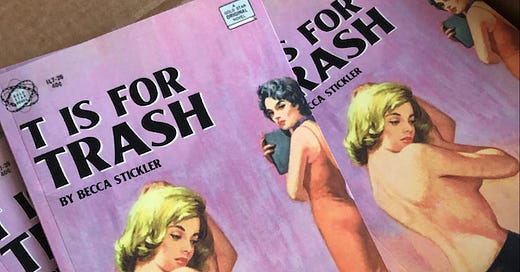Hello hello,
Some exciting news (that you may have already seen on Instagram): I wrote a zine about lesbian pulp fiction!
More specifically, it’s about the history of the genre, lesbian bar culture in the 1950s & ‘60s, literary lesbian drama, and trashy entertainment. If you read this newsletter, I’m pretty confident you’ll be into it.
The first batch of test zines arrived yesterday, which I sold on Instagram at a discounted price. If you ordered one of those, thank you!! It is already in the mail, on its way to you.
Now, I’m making (or, more accurately, Alanna is making) a few minor changes to the formatting, and I’ll be getting a bunch more printed ASAP. If you’d like to claim one of these, you can pre-order a copy now. You’ll receive it the week after next, and be one of the very first people to read T is for Trash. You’ll also get free shipping!
In case you’re not yet convinced, I’ve also included an excerpt here from the zine’s introduction:
On July 18, 2020, I searched for “lesbian art” on Etsy. I was planning the decor of my girlfriend’s new apartment before she moved in a few weeks, where I’d also be living by the end of September.
After scrolling through a few pages of corny rainbow art, something caught my eye. It was a print of a painted book cover from the 1950s, with a provocative drawing of two women, presumably in a bedroom. A blonde woman sits topless on a bed, her eyes cast down at the sheets, while a brunette in a slip dress stands in the distance, gazing at her. It’s undeniably sexual.
The title of the book, all the gay girls, makes it fairly clear what a reader might expect in its pages. The copy at the bottom of the cover is equally unsubtle: “Martha was interested in three things: power, money and beautiful young women.” Good for Martha.
The seller, PulptasticPrints, had dozens of covers just like this one in their storefront. I spent about an hour poring over them and sent my favorites to my girlfriend, who was napping in bed beside me. When she woke up a few hours later, she didn’t acknowledge the dozen or so texts.
I took that to mean that she wasn’t into the idea of covering her new place in lesbian pulp art. As it turns out, she just wasn’t feeling well. We’d find out a few days later that she’d contracted Salmonella, part of a nationwide outbreak in the red onion supply. Either way, I forgot about the covers for almost a year.
In the meantime, I spent a lot of time reading my way through the queer “classics.” After studying literature in college, I felt like I had a decent grasp on the American literary canon, a phrase I feel incredibly pretentious even typing. But this collection of books is generally very heterosexual. And even when queer authors were included in my class syllabi, their queerness was left out of the story.
The fact that I managed to graduate before realizing that Virginia Woolf was gay, for example, is possibly a personal failure—but I also blame my professors for choosing to teach her work solely from a feminist perspective, and not from a gay one.
Anyway, in the fall of 2020 I decided to create my own mini syllabi of queer lit, with a focus on women writers. This list, compiled primarily from the Google search results for “classic lesbian literature,” started with Radclyffe Hall, Virginia Woolf, and Gertrude Stein in the 1920s, Patricia Highsmith and Jane Rule in the ‘50s and ‘60s, and Rita Mae Brown, Audre Lorde, and Adrienne Rich in the ‘70s.
For a 50-year timespan, it’s a pretty sparse list. And at some point, my brain wandered back to the pulp fiction covers. Why hadn’t any of those books shown up on the dozens of lists of lesbian literature I’d bookmarked? And how could I get my hands on copies of them?
When I found myself mostly-unemployed in April 2021, I had plenty of time to dig for answers to these questions. What I found was the story of lesbian pulp—a tale of literary disputes, a homophobic postal service, lots of pen names, and ample dyke drama. And you’ll find it all in this very zine.
Thanks for reading this far! And if you have any questions, just reply to this email to get in touch.




